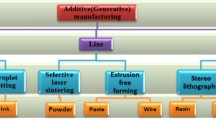Abstract
The currently available 3D printing still cannot simultaneously deal with the metal and nonmetal inks together due to their huge difference in the melting points and poor compatible printability between each other. Here through introducing the low melting point alloy Bi35In48.6Sn16Zn0.4 and silicone rubber as functional inks, we proposed a compatible hybrid 3D printing method for manufacturing the desired device, the supporting substrate and the allied package structure together. The principle of pneumatic-typed 3D printing of multiple inks was described and typical physical properties of the ink Bi35In48.6Sn16Zn0.4 were measured. Several key factors dominating the printing quality such as the temperature of the printing head, the air pressure exerted upon the liquid metal ink in the syringe, the moving velocity and the height of the printing head etc. were clarified. A general way of directly printing out 3D structured electronic devices consisting of both metal and nonmetal materials was demonstrated. Such hybrid objects were patterned and formed up layer by layer with Bi35In48.6Sn16Zn0.4 alloy and silicone rubber which would become solidified after standing for a period of time under room temperature. To illustrate the compatible printability of these printing inks, a three-layer tricolor LED stereo circuit with controlled lighting capability was further manufactured and evaluated. The present study opens an important hybrid 3D printing way for directly manufacturing functional and structural end devices in an easy and low cost way.
Similar content being viewed by others
References
Symes M D, Kitson P J, Yan J, et al. Integrated 3D-printed reactionware for chemical synthesis and analysis. Nat Chem, 2012, 4: 349–354
Griffith L G, Naughton G. Tissue engineering-current challenges and expanding opportunities. Science, 2002, 295: 1009
Seyednejad H, Gawlitta D, Dhert W J A, et al. Preparation and characterization of a three-dimensional printed scaffold based on a functionalized polyester for bone tissue engineering applications. Acta Biomater, 2011, 7: 1999–2006
Therriault D, White S R, Lewis J A. Chaotic mixing in three-dimensional microvascular networks fabricated by direct-write assembly. Nat Mater, 2003, 2: 265–271
Lopes A J, MacDonald E, Wicker R B. Integrating stereolithography and direct print technologies for 3D structural electronics fabrication. Rapid Prototyping J, 2012, 18: 129–143
Gu D D, Meiners W, Wissenbach K, et al. Laser additive manufacturing of metallic components: Materials, processes and mechanisms. Int Mater Rev, 2012, 57: 133–164
Asgharzadeh H, Simchi A. Effect of sintering atmosphere and carbon content on the densification and microstructure of laser-sintered M2 high-speed steel powder. Mat Sci Eng A-Struct, 2005, 403: 290–298
Santos E C, Shiomi M, Osakada K, et al. Rapid manufacturing of metal components by laser forming. Int J Mach Tool Manu, 2006, 46: 1459–1468
Zheng Y, He Z, Gao Y, et al. Direct desktop printed-circuits-on-paper flexible electronics. Sci Rep, 2013, 3: 1786
Ladd C, So J H, Muth J, et al. 3D printing of free standing liquid metal microstructures. Adv Mater, 2013, 25: 5081–5085
Tabatabai A, Fassler A, Usiak C, et al. Liquid-phase gallium-indium alloy electronics with microcontact printing. Langmuir, 2013, 29: 6194–6200
Boley J W, White E L, Chiu G T C, et al. Direct writing of gallium-indium alloy for stretchable electronics. Adv Funct Mater, 2014
Kim G, Son J, Park S, et al. Hybrid process for fabricating 3D hierarchical scaffolds combining rapid prototyping and electrospinning. Macromol Rapid Comm, 2008, 29: 1577–1581
Chang S C, Bharathan J, Yang Y, et al. Dual-color polymer light-emitting pixels processed by hybrid inkjet printing. Appl Phys Lett, 1998, 73: 2561–2563
Li L, Saedan M, Feng W, et al. Development of a multi-nozzle drop-on-demand system for multi-material dispensing. J Mater Process Technol, 2009, 209: 4444–4448
Xu T, Binder K W, Albanna M Z, et al. Hybrid printing of mechanically and biologically improved constructs for cartilage tissue engineering applications. Biofabrication, 2013, 5: 015001
Mannoor M S, Jiang Z, James T, et al. 3D printed bionic ears. Nano Lett, 2013, 13: 2634–2639
Cahill D G, Pohl R O. Lattice-vibrations and heat-transport in crystals and glasses. Ann Rev Phys Chem, 1988, 39: 93–121
Author information
Authors and Affiliations
Corresponding author
Rights and permissions
About this article
Cite this article
Wang, L., Liu, J. Compatible hybrid 3D printing of metal and nonmetal inks for direct manufacture of end functional devices. Sci. China Technol. Sci. 57, 2089–2095 (2014). https://doi.org/10.1007/s11431-014-5657-3
Received:
Accepted:
Published:
Issue Date:
DOI: https://doi.org/10.1007/s11431-014-5657-3




